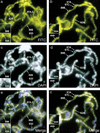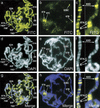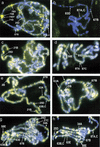Phosphorylation of histone H3 correlates with transcriptionally active loci
- PMID: 11114889
- PMCID: PMC317109
- DOI: 10.1101/gad.848800
Phosphorylation of histone H3 correlates with transcriptionally active loci
Abstract
Posttranslational modifications of the N-terminal tails of the core histones within the nucleosome particle are thought to act as signals from the chromatin to the cell for various processes. The experiments presented here show that the acetylation of histones H3 and H4 in polytene chromosomes does not change during heat shock. In contrast, the global level of phosphorylated H3 decreased dramatically during a heat shock, with an observed increase in H3 phosphorylation at the heat shock loci. Additional experiments confirm that this change in phosphorylated H3 distribution is dependent on functional heat shock transcription factor activity. These experiments suggest that H3 phosphorylation has an important role in the induction of transcription during the heat shock response.
Figures






Similar articles
-
Phosphorylation of histone H3 during transcriptional activation depends on promoter structure.Genes Dev. 2003 Jan 1;17(1):43-8. doi: 10.1101/gad.1021403. Genes Dev. 2003. PMID: 12514098 Free PMC article.
-
Roles of histone acetylation modification in basal and inducible expression of hsp26 gene in D. melanogaster.Mol Cell Biochem. 2007 Dec;306(1-2):1-8. doi: 10.1007/s11010-007-9547-x. Epub 2007 Jul 10. Mol Cell Biochem. 2007. PMID: 17619947
-
Protein phosphatase 2A activity affects histone H3 phosphorylation and transcription in Drosophila melanogaster.Mol Cell Biol. 2003 Sep;23(17):6129-38. doi: 10.1128/MCB.23.17.6129-6138.2003. Mol Cell Biol. 2003. PMID: 12917335 Free PMC article.
-
Phosphorylation of histone H3 in plants--a dynamic affair.Biochim Biophys Acta. 2007 May-Jun;1769(5-6):308-15. doi: 10.1016/j.bbaexp.2007.01.002. Epub 2007 Jan 19. Biochim Biophys Acta. 2007. PMID: 17320987 Review.
-
Inducible covalent posttranslational modification of histone H3.Sci STKE. 2005 Apr 26;2005(281):re4. doi: 10.1126/stke.2812005re4. Sci STKE. 2005. PMID: 15855410 Review.
Cited by
-
Histone deacetylase inhibitors: clinical implications for hematological malignancies.Clin Epigenetics. 2010 Sep;1(1-2):25-44. doi: 10.1007/s13148-010-0006-2. Epub 2010 Jul 28. Clin Epigenetics. 2010. PMID: 22704087 Free PMC article.
-
Lessons from the genome sequence of Neurospora crassa: tracing the path from genomic blueprint to multicellular organism.Microbiol Mol Biol Rev. 2004 Mar;68(1):1-108. doi: 10.1128/MMBR.68.1.1-108.2004. Microbiol Mol Biol Rev. 2004. PMID: 15007097 Free PMC article. Review.
-
Phosphorylated Histone 3 at Serine 10 Identifies Activated Spinal Neurons and Contributes to the Development of Tissue Injury-Associated Pain.Sci Rep. 2017 Jan 25;7:41221. doi: 10.1038/srep41221. Sci Rep. 2017. PMID: 28120884 Free PMC article.
-
BIR-1, a Caenorhabditis elegans homologue of Survivin, regulates transcription and development.Proc Natl Acad Sci U S A. 2003 Apr 29;100(9):5240-5. doi: 10.1073/pnas.0730770100. Epub 2003 Apr 7. Proc Natl Acad Sci U S A. 2003. PMID: 12682297 Free PMC article.
-
Changes in chromatin structure correlate with transcriptional activity of nucleolar rDNA in polytene chromosomes.Chromosoma. 2009 Jun;118(3):303-22. doi: 10.1007/s00412-008-0198-9. Epub 2008 Dec 9. Chromosoma. 2009. PMID: 19066928
References
-
- Ashburner M. Patterns of puffing activity in the salivary gland chromosomes of Drosophila. V. Responses to environmental treatments. Chromosoma. 1970;31:356–376. - PubMed
-
- ————— Puffing patterns in Drosophila melanogaster and related species. Results Probl Cell Differ. 1972;4:101–151. - PubMed
-
- ————— . Drosophila. Cold Spring Harbor, NY: Cold Spring Harbor Laboratory Press; 1989.
-
- Ashburner M, Bonner JJ. The induction of gene activity in Drosophila by heat shock. Cell. 1979;17:241–254. - PubMed
Publication types
MeSH terms
Substances
Grants and funding
LinkOut - more resources
Full Text Sources
Other Literature Sources
Molecular Biology Databases
